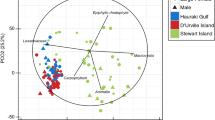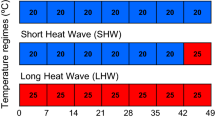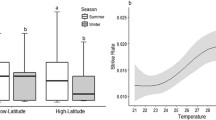Abstract
Previous feeding studies on herbivorous marine snails rarely have focused on temperature effects on food intake. If temperature affects food intake, ectothermic snails may experience difficulty obtaining sufficient nutritional resources, limiting their ability to sustain populations at suboptimal temperatures. We hypothesized that the feeding responses of Tegula species would correspond with temperatures characteristic of their geographic distributions. We determined activity, consumption rates, and gut passage times at 11°C, 15°C, 19°C, and 23°C for three Tegula species with distinct thermal distributions: T. brunnea (cold water), T. aureotincta (warm water), and individuals from warm- and cold-water populations of T. funebralis, a broadly distributed species. Activity and consumption rates of T. aureotincta increased with increasing temperature, but were highest for T. brunnea at 19°C, a temperature rarely achieved in habitats occupied by this species, and lowest at 11°C. Warm-water T. funebralis showed significantly lower activity and consumption rates at 11°C, whereas cold-water T. funebralis consumed food fastest at 15°C and were most active at 23°C. Temperature affected gut passage time only in T. aureotincta. These data suggest that temperature might influence the northern limit of T. aureotincta by affecting activity and food consumption rates. T. brunnea’s activity and ability to consume food were not hindered by warmer temperatures despite the present day restriction of this species to colder waters. Also, widely separated (>300 km) T. funebralis populations may be adapted to regional conditions based on the different temperature responses of northern and southern snails.




Similar content being viewed by others
References
Ansell AD (1982) Experimental studies of a benthic predator–prey relationship. I. Feeding, growth, and egg-collar production in long-term cultures of the gastropod drill Polinices alderi (Forbes) feeding on the bivalve Tellina tenuis (da Costa). J Exp Mar Biol Ecol 56:235–255
Ault JS (1985) Some quantitative aspects of reproduction and growth of the red abalone, Haliotis rufescens Swainson. J World Maricult Soc 16:398–425
Bakun A (1999) A dynamic scenario for simultaneous regime-scale shifts in widely separated large marine ecosystems of the Pacific. In: Sherman K, Tang Q (eds) Large marine ecosystems of the Pacific Rim. Assessment, sustainability, and management. Blackwell Science, Malden, pp 2–26
Barry JP, Baxter CH, Sagarin RD, Gilman SE (1995) Climate-related, long-term faunal changes in a California rocky intertidal community. Science 267:672–675
Bayne BL, Scullard C (1978) Rates of feeding by Thais (Nucella) lapillus (L.). J Exp Mar Biol Ecol 32:113–129
Belcik FP (1965) Note on a range extension and observations of spawning in Tegula, a gastropod. Veliger 7:233–234
Best B (1964) Feeding activities of Tegula funebralis (Mollusca: Gastropoda). Veliger 6[Suppl]:42–45
Borsa P, Benzie JAH (1996) Population genetics of Trochus niloticus and Tectus coerulescens, topshells with short-lived larvae. Mar Biol 125:531–541
Carefoot TH (1987) Gastropoda. In: Pandian TJ, Vernberg FJ (eds) Animal energetics. Academic, San Diego, pp 89–172
Chavez FP, Ryan J, Lluch-Cota SE, Ñiquen MC (2003) From anchovies to sardines and back: multidecadal change in the Pacific Ocean. Science 299:217–221
Cronin G, Hay ME (1996) Induction of seaweed chemical defenses by amphipod grazing. Ecology 77:2287–2301
Dehnel PA (1956) Rates of growth of gastropods as a function of latitude. Physiol Zool 28:115–144
Edwards DC, Huebner JD (1977) Feeding and growth rates of Polinices duplicatus preying on Mya arenaria at Barnstable Harbor, Massachusetts. Ecology 58:1218–1236
Fawcett MH (1984) Local and latitudinal variation in predation on an herbivorous marine snail. Ecology 65:1214–1230
Foster GG, Hodgson AN (1998) Consumption and apparent dry matter digestibility of six intertidal macroalgae by Turbo sarmaticus (Mollusca: Vetigastropoda: Turbinidae). Aquaculture 167:211–227
Frank PW (1975) Latitudinal variation in the life history features of the black turban snail Tegula funebralis (Prosobranchia: Trochidae). Mar Biol 31:181–192
Gaines S (1997) Biogeographic boundaries and species distribution. Alolkoy, Winter
Gao X, Liu Y, Liu Y, Liu J (1990) Influence of temperature on feeding and growth of the young abalone. Oceanol Limnol Sin 21:20–26
Garton D, Stickle WB (1980) Effects of salinity and temperature on the predation rate of Thais haemastoma on Crassostrea virginica spat. Biol Bull (Woods Hole) 158:49–57
Gaylord B, Gaines SD (2000) Temperature or transport? Range limits in marine species mediated solely by flow. Am Nat 155:769–789
Gilroy A, Edwards SJ (1998) Optimum temperature for growth of Australian abalone: preferred temperature and critical thermal maximum for blacklip abalone, Haliotis rubra (Leach), and greenlip abalone, Haliotis laevigata (Leach). Aquacult Res 29:481–485
Goodson J (2003) Longterm changes in rocky intertidal populations and communities at Little Corona del Mar, California: a synthesis using traditional and non-traditional data. MS thesis, California State University, Fullerton
Hahn KO (1989) Handbook of culture of abalone and other marine gastropods. CRC Press, Boca Raton, Fla., USA
Hall CA (1960) Displaced Miocene molluscan provinces along the San Andreas fault, California. Univ Calif Publ Geol Sci 34:281–308
Halliday EB (1991) The natural history and feeding ecology of Astraea undosa in a Southern California kelp forest. MS thesis, University of California, Santa Cruz
Hedgpeth JW (1957) Marine biogeography. In: Hedgepeth JW (ed) Treatise on marine ecology and paleoecology, vol 1. Ecology. Memoir 67, Geological Society of America, Washington DC, pp 359–382
Hellberg ME (1998) Sympatric sea shells along the sea’s shore: the geography of speciation in the marine gastropod Tegula. Evolution 52:1311–1324
Heslinga GA (1981) Growth and maturity of Trochus niloticus in the laboratory. In: Gomez, et al (eds) Proc Int Coral Reef Symp, vol 1. University of the Philippines, Manila, pp 39–45
Hickey BM (1993) Physical oceanography. In: Dailey MD, Reish DJ, Anderson JW (eds) Ecology of the Southern California Bight. A synthesis and interpretation. University of California Press, Berkeley, pp 19–70
Hines A, Anderson S, Brisbin M (1980) Heat tolerance in the black abalone, Haliotis cracherodii Leach, 1814: effects of temperature fluctuation and acclimation. Veliger 23:113–118
Hochachka PW, Somero GN (1984) Biochemical adaptation. Princeton University Press, Princeton
Horn MH, Allen LG (1978) A distributional analysis of California coastal marine fishes. J Biogeogr 5:23–42
Hutchins LW (1947) The bases for temperature zonation in geographical distribution. Ecol Monogr 17:325–335
Imai T (1977) Aquaculture in shallow seas: progress in shallow sea culture, part IV. Amerind, New Delhi
Leighton DL (1966) Studies of food preference in algivorous invertebrates of Southern California kelp beds. Pac Sci 20:104–113
Leighton DL (1974) The influence of temperature on larval and juvenile growth in three species of Southern California abalones. Fish Bull (Wash DC) 72:1137–1145
Marchetti KE, Geller JB (1987) The effects of aggregation and microhabitat on desiccation and body temperature of the black turban snail, Tegula funebralis (A. Adams, 1855). Veliger 30:127–133
McGowan JA, Cayan DR, Dorman LM (1998) Climate–ocean variability and ecosystem response in the northeast Pacific. Science 281:210–217
McGowan JA, Chelton DB, Conversi A (1999) Plankton patterns, climate, and change in the California Current. In: Sherman K, Tang Q (eds) Large marine ecosystems of the Pacific Rim. Assessment, sustainability, and management. Blackwell Science, Malden, pp 63–105
McLean JH (1962) Manometric measurements of respiratory activity in Tegula funebralis. Veliger 4:191–193
McLean JH (1978) Marine shells of Southern California. Nat Hist Mus Los Angeles County Sci Ser 24
Moran AL (1997) Spawning and larval development of the black turban snail Tegula funebralis (Prosobranchia: Trochidae). Mar Biol 128:107–114
Morris RH, Abbott DL, Haderlie EC (1980) Intertidal invertebrates of California. Stanford University Press, Stanford
Murray SN, Littler MM (1981) Biogeographical analysis of intertidal macrophyte floras of Southern California. J Biogeogr 8:339–351
Navarro JM, Leiva GE, Martinez G, Aguilera C (2000) Interactive effects of diet and temperature on the scope for growth of the scallop Argopecten purpuratus during reproductive conditioning. J Exp Mar Biol Ecol 247:67–83
Newell IM (1948) Marine molluscan provinces of western North America: a critique and a new analysis. Proc Am Philos Soc 92:155–166
Newell RC, Pye VI, Ahsanullah M (1971) Factors affecting the feeding rate of the winkle Littorina littorea. Mar Biol 9:138–144
Paine RT (1969) The Pisaster–Tegula interaction: prey patches, predator food preference, and intertidal community structure. Ecology 50:950–961
Paine RT (1971) Energy flow in a natural population of the herbivorous gastropod Tegula funebralis. Limnol Oceanogr 16:86–98
Palmer AR (1982) Growth in marine gastropods: a non-destructive technique for independently measuring shell and body weight. Malacologia 23:63–73
Quinn GP, Keough MJ (2002) Experimental design and data analysis for biologists. Cambridge University Press, Cambridge
Ricketts EF, Calvin J, Hedgpeth JW (1985) Between Pacific tides. Stanford University Press, Stanford
Rosas RA, Moye GT, Heredia AA (1990) Qualitative analysis of the macroalgal diet of the snail Astraea undosa Wood, 1828, in Punta Banda, Baja California, Mexico. Cienc Mar 16:111–120
Sagarin RD, Gaines SD (2002) Geographical abundance distributions of coastal invertebrates: using one-dimensional ranges to test biogeographic hypotheses. J Biogeogr 29:985–997
Sagarin RD, Barry JP, Gilman SE, Baxter CH (1999) Climate-related change in an intertidal community over short and long time scales. Ecol Monogr 69:465–490
Sanford E (1999) Regulation of keystone predation by small changes in ocean temperature. Science 283:2095–2097
Sanford E (2002) The feeding, growth, and energetics of two rocky intertidal predators (Pisaster ochraceus and Nucella canaliculata) under water temperatures simulating episodic upwelling. J Exp Mar Biol Ecol 273:199–218
Sato LM (2001) Variation in the density, size structure, and reproductive characteristics of intertidal Tegula populations on Southern California rocky shores. MS thesis, California State University, Fullerton
Schmitt RJ (1981) Contrasting anti-predator defenses of sympatric marine gastropods (family Trochidae). J Exp Mar Biol Ecol 54: 251–263
Seapy RR, Littler MM (1980) Biogeography of rocky intertidal macroinvertebrates of the Southern California Islands. In: Power DM (ed) The California islands: proceedings of a multidisciplinary symposium. Santa Barbara Museum of Natural History, Santa Barbara, pp 307–323
Steinberg PD (1985) Feeding preferences of Tegula funebralis and chemical defenses of marine brown algae. Ecol Monogr 55:333–349
Stickle WB, Moore MN, Bayne BL (1985) Effects of temperature, salinity and aerial exposure on predation and lysosomal stability of the dogwhelk Thais (Nucella) lapillus (L.). J Exp Mar Biol Ecol 93:235–258
Todd CD (1998) Larval supply and recruitment of benthic invertebrates: do larvae always disperse as much as we believe? Hydrobiologia 375/376:1–21
Tomanek L, Somero GN (1999) Evolutionary and acclimation-induced variation in the heat-shock responses of congeneric marine snails (genus Tegula) from different thermal habitats: implications for limits of thermotolerance and biogeography. J Exp Biol 202:2925–2936
Tomanek L, Somero GN (2000) Time course and magnitude of synthesis of heat-shock proteins in congeneric marine snails (genus Tegula) from different tidal heights. Physiol Biochem Zool 73:249–256
Uki N, Kikuchi S (1982) Influence of food levels on maturation and spawning of the abalone, Haliotis discus hannai related to effective accumulative temperature. Bull Tohoku Reg Fish Res Lab 45:45–52
Uki N, Grant JF, Kikuchi S (1981) Juvenile growth of the abalone, Haliotis discus hannai, fed certain benthic microalgae related to temperature. Bull Tohoku Reg Fish Res Lab 43:59–64
Valentine JW (1966) Numerical analysis of marine molluscan ranges on the extra tropical northeastern Pacific shelf. Limnol Oceanogr 11:198–211
Wakefield RL, Murray SN (1998) Factors influencing food choice by the seaweed-eating marine snail Norrisia norrisi (Trochidae). Mar Biol 130:631–642
Wara WM, Wright BB (1964) The distribution and movement of Tegula funebralis in the intertidal region of Monterey Bay, California. Veliger 6[Suppl]:30–37
Watanabe JM (1984) Food preference, food quality and diets of three herbivorous gastropods (Trochidae: Tegula) in a temperate kelp forest habitat. Oecologia 62:47–52
Wyban J, Walsh WA, Godin DM (1995) Temperature effects on growth, feeding rate and feed conversion of the Pacific white shrimp (Penaeus vannamei). Aquaculture 138:267–279
Acknowledgements
We would like to acknowledge the assistance of D. Reid, J. Dodge, S. Phelps, and E. Seale in performing aspects of this study. We are grateful for the assistance and suggestions provided by K. Dickson and M. Horn on earlier drafts of this paper. We thank K. Donovan for assistance in preparing Fig. 1. E.H.Y. was supported as a University of Southern California Sea Grant Trainee during this study, and would also like to acknowledge support from a CSU Graduate Equity Fellowship. Support for this research was provided by the Departmental Association Council and the Department of Biological Science at California State University, Fullerton, the Frank M. Doyle Foundation and by a Sigma Xi grant. All procedures used in these experiments comply with the current laws of the United States of America.
Author information
Authors and Affiliations
Corresponding author
Additional information
Communicated by P.W. Sammarco, Chauvin
Rights and permissions
About this article
Cite this article
Yee, E.H., Murray, S.N. Effects of temperature on activity, food consumption rates, and gut passage times of seaweed-eating Tegula species (Trochidae) from California. Marine Biology 145, 895–903 (2004). https://doi.org/10.1007/s00227-004-1379-6
Received:
Accepted:
Published:
Issue Date:
DOI: https://doi.org/10.1007/s00227-004-1379-6




